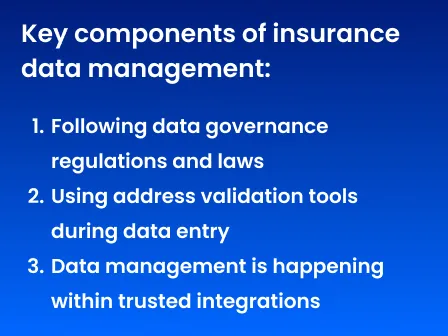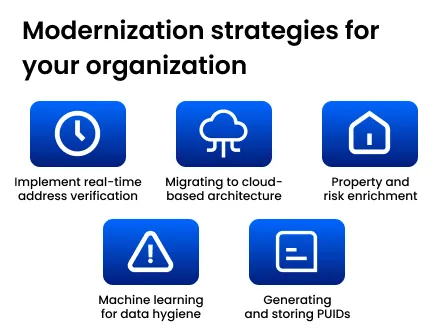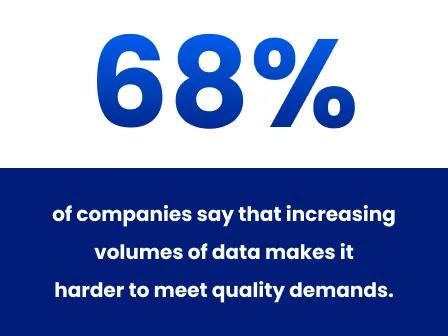Insurance data management: Address verification is a cornerstone

Insurance data management is the process that insurers and reinsurance companies use to collect, store, organize, clean, and analyze policyholders’ data. Many teams use this data, such as underwriting, claims, brokers, actuaries, and adjusters. Good insurance data management helps make accurate risk checks, follow rules, speed up work, and, most importantly, improve customer experience (and your NPS scores).
Smarty’s data management software is a great example of what insurance data management should look like. (In fact, if you ask Guidewire, we might just be the golden child for address data accuracy.) Try some of our address data management products below, completely free, or keep reading along to learn more about effectively managing your insurance data.
Insurance data management topics to be discovered? Yes please! Here’s what you can expect to learn about in this article:
- The importance of data management in insurance
- Role of Master Data Management (MDM)
- Key components of insurance data management
- Challenges in insurance data management
- Leveraging data analytics for business growth
- The bottom line on insurance data management
The importance of data management in insurance
Customer data management is essential for insurance industry giants for many reasons: enhancing operational efficiency, improving customer experiences, and ensuring regulatory compliance are among the top. The cornerstones to achieving truly effective data management in insurance boil down to 1) address verification technology, 2) rooftop/building accurate geocodes, 3) autocomplete tools, and 4) property risk data. Let’s expand.
Enhancing operational efficiency for insurance
The tools you need to enhance your operational efficiency are address verification, address autocomplete, and rooftop-level geocoding.
Address verification improves operational efficiency because your book of business is validated addresses, duplicate-free, and standardized for easier integration into your workflows. You’re reducing wasted time tracking down bad data, minimizing delays due to misrouted mail, and ensuring that policy documents, claims checks, and notices arrive precisely when needed.
Address autocomplete helps operations both outside and inside the company. Users like adjusters, claims processing teams, and customers can type one letter, and then, the system shows correct addresses to pick from. Each letter typed narrows the choices.
This is especially useful for your organization if you have online applications or purchase options for policies. Address autocomplete prevents typing errors and saves time. It slashes form completion time and virtually eliminates typos or incomplete entries.
Rooftop-level geocoding boosts operational efficiency up a notch by pinpointing the exact building on a parcel instead of just the center of the property. This accuracy is especially valuable information for underwriting and program development, especially for rural areas where the home you’re insuring may exist on a corner of a property that’s multiple acres in size.
It’s also valuable for densely populated areas where one land parcel may hold hundreds of units, like an apartment or business complex. The rooftop-level geocode eliminates time searching for where on the parcel the insured’s property is located, taking out the guesswork with flood zones, fire risk, or other hazards dependent on exact coordinates for a building.
Using persistent, unique identifiers—also known as PUIDs—across addresses ensures that once an address is verified and geocoded, that exact version of it’s trackable and referenceable across your internal systems and third-party vendors. And, with US Address Verification and many of our other products as well, that PUID (SmartyKey®) is free with your subscription. No more duplicate entries, mismatched records, or guesswork.
Improving customer experiences in insurance

The tools you need to improve customer experiences are address verification and address autocomplete.
Address verification puts smiles on your customers' faces because you will be one of the companies in their lives who knows how to communicate well. From policy documents to claims checks to deploying a claims adjuster, your team and your customers can trust that they’ll arrive on time and at the right place, building trust that lasts through insurance claims.
Address autocomplete enhances the experience right at the point of entry. Customers (and even your internal agents, adjusters, and customer support teams) can complete forms faster and with fewer errors, reducing friction during quotes, applications, or claims processing.
Address verification: ensuring regulatory compliance
The tools you need to ensure you pass regulatory compliance checks are address verification and rooftop geocoding.
Address verification keeps the legal team from sweating because compliance concerns clean, trackable, and organized data and communications. Maintaining accurate, standardized, and current addresses in your database is a key requirement for many compliance upholders.
Clean address records help insurers comply with privacy, anti-money laundering (AML), and Know Your Customer (KYC) rules by verifying that customer information is correct and can be delivered.
Rooftop geocodes ensure compliance with the powers that be in a geographic-specific kinda way.
Flood zone or wildfire risk disclosures are much more accurate when the pin of the geocode actually lands on the roof of the structure a customer wants insured. You can confidently assess and report exposures by state, federal, or industry requirements, as well as protect yourself from legal action that might be taken against you for over- or underinsured properties.

Preventing and mitigating insurance data breaches
An insurance data breach can cost millions in fines, lost business, and customer trust. For insurers, data protection insurance helps after the fact, but prevention starts with clean, secure data.
Many of these breaches? They start with bad address data. A mismatched address may seem harmless, but it can open the door to identity fraud, policy manipulation, and compliance violations. Smarty’s insurance data services—including address verification, autocomplete, and rooftop geocoding—lock down this critical point of vulnerability.
- Real-time validation stops fraudulent entries before they reach your system.
- Persistent unique identifiers (PUIDs) keep addresses tied to the right customer, even if formats change.
- Encrypted lookups protect sensitive data in transit.
- Ongoing re-validation catches suspicious changes fast.
Whether you carry data insurance or data breach insurance, pairing it with secure, accurate address management slashes breach risk and keeps your customer trust intact.
Role of Master Data Management (MDM)
When it comes to the insurance industry's data management, Master Data Management (MDM) plays a vital role in wrangling complexity, enforcing data quality, and delivering a consistent view of critical business information. Here’s how and why that matters for your business.
Addressing data complexity in the insurance industry
Insurance data complexity boils down to a few main contributors.
Not only do insurance firms manage a massive amount of aggregate data from varying levels of authoritative and non-authoritative sources (think policies, claims management, agency portals, CRM platforms, third-party providers, and even insureds themselves), but they all feed into disparate systems. This leads to duplicated information, inconsistent formatting, and siloed views of the same entities.
MDM tools like Smarty’s combine conflicting sources into one place. They do data standardization, fuzzy matching, deduplication, and record linking. This builds a "golden record" for each entity.
This process supports the multi-domain insurance industry's needs by covering customers, streamlining policy underwriting, and enabling effective claims history management—everything you could ever want in your insurance data management software.
Ensuring data quality and consistency
When data is clean and deduplicated, you can also rely on the quality of your data and the consistency of that data moving forward. MDM mechanisms enforce completeness, correctness, and consistency across the organization’s insurance data:
- Accuracy: Validates entries that reflect the real world, e.g., correct customer or policy info and eliminates transcription/P.O. Box errors.
- Consistency: Applies data governance and business rules so data looks the same across systems—same codes, formats, or nomenclature, no matter the channel.
- Reliability over time: Monitors and maintains data freshness, audits changes, and builds stewardship workflows so users always access “fit‑for‑use” data.
By systematically profiling, standardizing, cleansing, merging, and ongoing monitoring, insurance MDM provides a trusted single version of the truth, that “golden record,” which is essential for analytics, underwriting, pricing, claims processing automation, and artificial intelligence use cases.
Assigning a PUID to each address using address verification or geocoding services from Smarty enables insurers to connect, reference, and enrich that location record consistently—even if it's updated later or pulled from different systems. PUIDs act as the “fingerprint” for each location, keeping your address data stitched together across time and touchpoints.
Key components of insurance data management

Integrous insurance data management comes down to answering “yes” to these 3 questions:
- Are you following data governance regulations and laws, and do you have responsible parties assigned to continuous monitoring?
- Are you implementing data modernization strategies to ensure that your data is always up to date, accurate, and fully enriched for the most refined CAT and risk modeling?
Specifically, are you continuously using address validation tools during data entry to check data accuracy? (Did you know that even verified and validated addresses can change over time?) - If you are not completely in charge of how your insurance data is stored and handled, is your insurance data management happening within trusted integrations or insuretech platforms that answered yes to questions 1 and 2?
Data governance and policy frameworks
Successful data management relies on data governance and stewardship, standards compliance (ISO 8000 anyone?), and how to set up the system.
Defined roles and responsibilities within your organization can help you with stewardship. If everyone knows who the data owner is, who is in charge of what area of data governance, how often audits are applied to your database, etc., it’s much easier to work as a team to maintain data integrity and data security.
ISO 8000 provides guidelines for structuring those roles and responsibilities and clear requirements for master data exchange, portability, definitions, and data quality measures. With a roadmap to follow, your teams will be empowered to be on the same page regarding what is being asked of them for effective data governance and insurance data management (and it’ll keep the red-tape police away from you and your financial gains).
Even though you aren’t an architect, we need to mention how your data management system's architecture should be structured to ensure the best possible chance for easy success. The key cornerstones?
- Consolidation architecture: Data is pulled from source systems, cleaned with address cleansing tools, and stored centrally in a read-only hub.
- Registry architecture: A system to index and link records from source systems using metadata points and matching rules. No physical data is stored here—just references.
- Coexistence architecture: A system that combines central data governance with bi-directional data flows. Essentially, the “golden record” is maintained centrally but updates as information flows to and from source systems.
- Centralized hub architecture: This is the big cheese system, the single authoritative source where all master data and “golden records” are created, changed, and where consumption happens.
Insurance industry data modernization strategies
You might be panicking and ripping down the infrastructure of what you have. WAIT! Don’t panic. Modernizing your insurance data management approach doesn’t mean you need to go back to the drawing board. We’re just asking you to apply the latest tools and principles to what you’re already doing. This ensures your data stays accurate, enriched, and real-time friendly, which will help you stay ahead of your competitors.
Modernizing your data strategies can also save you some serious cash; we’re talking $12.9 million per year, according to Garnter’s most recent study on poor data quality.
Modernization strategies for your organization could include:

- Implementing real-time address verification APIs to prevent bad data from entering your systems.
- Migrating legacy systems to cloud-based architecture for improved scalability and resilience.
- Property and risk enrichment can enhance first-party data with third-party intelligence to improve underwriting and fraud prevention.
- Applying machine learning for data hygiene—training algorithms to automatically spot anomalies and incomplete records.
- Generating and storing PUIDs for every verified address ensures persistent IDs across your policy, claims, and customer management systems.
Modernizing doesn’t have to be all at once, either. Do what makes sense for your organization and bandwidth. Something is better than nothing here. We believe in you!
Integration with advanced platforms (e.g., Guidewire)
For any insurer using modern core systems like Guidewire, Duck Creek, or Majesco, your insurance data management must seamlessly integrate with those platforms.
Smarty, for example, integrates directly into Guidewire Cloud and PolicyCenter. Thanks to the use of PUIDs, insurers can confidently connect address data across systems like Guidewire, Salesforce, and CRM platforms, even when addresses change slightly or get updated over time, enabling:
- Inline address verification at key touchpoints (quote, bind, claim intake)
- Real-time rooftop geocoding for hazard risk assessment
- Streamlined compliance with address standardization at the source
These integrations prevent data silos and ensure your downstream analytics and decision-making are based on clean, complete, duplicate-free data.
Challenges in insurance data management
Insurance data management isn’t all streamlined sunshine, rainbows, and tons of cash in your pockets. There can be some hurdles to getting exactly what you need, but we are here to discuss the challenges you may face and how to overcome them. TLDR, though, it all comes down to accurate address data.
Fragmented systems and legacy issues
Many insurance organizations operate across siloed legacy systems—claims here, policy admin there, a little CRM over there in the corner—each with its own version of the “Truth.” This fragmentation creates duplicate records, breeds poor regulatory reporting, and installs major roadblocks for customer 360° views.
How to overcome fragmentation
- USE SMARTY. We can’t emphasize this enough, but Smarty’s real-time APIs validate data at the point of entry across systems.
- Adopt an MDM strategy with coexistence architecture to unify and sync your data across systems without a full rip-and-replace.
- Integrate platforms like Guidewire, EigenRisk, and Cytora, which are already using Smarty to keep their systems clean.
* Pro tip: Start small. Connect 2 or 3 critical systems (claims, policy, and CRM) as a pilot, then scale across the enterprise after you watch the magic happen.
Third-party data inconsistencies

Increasing volumes of data make it tricky for your organization to keep the truth straight. In fact, 68% of companies say that the increase makes it harder to meet quality demands. Credit bureaus, property data vendors, public records, or any 3rd-party data providers can introduce conflicting or stale information. This isn’t great for your organization, which needs exact and up-to-date data for accurate policies.
How to overcome third-party data inconsistency
- Establish a data quality gate before you ingest 3rd-party data. Validate all incoming addresses against authoritative sources using Smarty’s CASS-certified tools. Use deduplication and standardization routines regularly to keep the information you store as your golden record.
- Score data by source confidence. You can create rules to prioritize the most trustworthy sources (like a verified address, property use type, or year built) over other less reliable fields or frequently changing ones (email, phone number, etc.)
* Pro tip: Address validation should be a standard practice. Smarty recommends running your address data through address validation tools every 30 days to keep the most updated information at your fingertips.
Impact on decision-making processes
Inaccurate or incomplete data leads to bad underwriting, flawed CAT modeling, failed communications, and regulatory exposure. Worse? You might not even know which decisions are built on bad data.
How to overcome bad decision-making from address data errors
- Embed address autocomplete and verification in every customer-facing (and internal manual-entry) workflow.
Clean data can be selected from the start with the use of tools like Smarty’s autocomplete products. You can also choose an insuretech that already integrates with Smarty. - Use audit trails and data lineage tools to track where data comes from, who touched it last, when, and what was changed or added.
This way, if inaccurate data is still sneaking in, you can more easily track down the problem and stop it at the source before you base any major decisions on the bad data.
Leveraging data analytics for business growth
Employing effective insurance data management tools offers insurers many business benefits, such as operational efficiency, improved risk management, increased fraud detection and prevention, enhanced customer service and user experiences, and fortified compliance and analytics readiness. Let’s discuss how address data management helps you with this.
Supporting more strategic decision-making
Data is boardroom currency. Executives increasingly rely on real-time dashboards, accurate location intelligence, and reliable risk models to make decisions that can impact billions of dollars in reserves, pricing strategies, and growth.
With trusted insurance data management systems in place, you can now visualize exposure across geographies (rooftop-level geocodes and property risk data), optimize portfolio balance, evaluate M&A opportunities, and adapt pricing strategies based on that newfound data trustworthiness.
Building trust with insurance stakeholders
Building trust with stakeholders starts with managing your data like it actually matters—because it does.
When address data is clean, verified, and governed, it sends a strong signal to regulators, reinsurers, investors, and policyholders that your operations are tight, your compliance is under control, and your teams are doing what they say they’re doing.
For regulators and compliance auditors, verified address data ensures that required documents and notices reach the right people at the right time, fulfilling obligations like KYC, AML, and location-specific disclosures. Reinsurers trust that your reported exposures match reality—not a mismatched ZIP Code or duplicate record. And internally, executive teams and investors see clean data as a proxy for operational maturity and reduced risk across the board.
Even your customers feel the difference. When a quote is accurate, a claim check arrives on time, or a policy renewal lands without error, they’re not thinking “Wow, what excellent data hygiene!”, but they’re experiencing the result of it. Verified address data removes the friction that erodes trust and replaces it with seamless, professional interactions.
In short, address verification keeps mail moving and confidence high. It’s the invisible thread connecting your compliance, communication, and credibility. The more certain you are of your data, the more certain everyone else can be in you.
The bottom line on insurance data management
Insurance data management is no longer a back-office function—it’s a strategic driver of customer experience, operational efficiency, compliance, and growth. While many tools contribute to strong data hygiene, address verification remains the cornerstone.
Clean, verified, enriched address data empowers you to improve risk analysis, streamline communication, satisfy regulators, and reduce costly manual errors.
Whether you’re focused on policy growth, claims accuracy, or reducing friction in digital experiences, start with your addresses. The rest of your data success will follow.
Remember to try out Smarty’s suite of tools for your insurance data management. Here’s a little table for easy reference.
| US | International | |
| *Address verification | Try now! | Try now! |
| Address autocomplete | Try now! | Try now! |
| Rooftop geocoding | Try now! | Try now! |
| Property risk data | Try now! | |
| Property data | Try now! | |
| Reverse geocoding | Try now! | |
| Master address list | Try now! |
*At least give address verification a shot. it’s the cornerstone of the insurance industry's success, after all. 😉